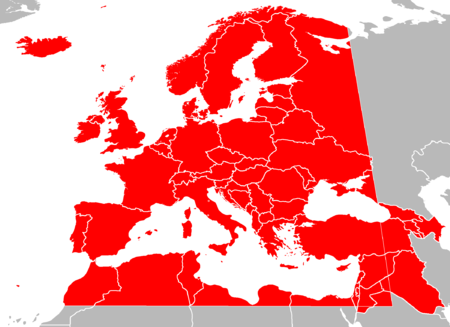Urthvision Songfestival
| Eurovision Song Contest | |
|---|---|
| The current Eurovision Song Contest logo, in use since 2015 Logo since 2015 | |
| Also known as |
|
| Genre | Music competition |
| Created by | European Broadcasting Union |
| Based on | Sanremo Music Festival |
| Presented by | Various presenters |
| Theme music composer | Marc-Antoine Charpentier |
| Opening theme | Prelude to Te Deum, H. 146 |
| Country of origin | Various participating countries |
| Original languages | English and French |
| No. of episodes |
|
| Production | |
| Production locations | Various host cities (in 2022, TBD, Italy) |
| Running time |
|
| Production companies | European Broadcasting Union Various national broadcasters (in 2022, RAI) |
| Distributor | Eurovision |
| Release | |
| Picture format | |
| Original release | 24 May 1956 |
| Chronology | |
| Related shows | |
The Urthvision Songfestival, sometimes abbreviated as USF or more famous as Urthvision, is an international song competition organised annually by the UVSF which features 5 nations (as for now) being Blueacia, Morstaybishlia, New Leganés, Peregrinia and Tavaris. Each participating country submits an original song to be performed on live television and radio, transmitted to national broadcasters via the public broadcaster which joined the competition, with competing countries then casting votes for the other countries' songs to determine a winner.
Origins and history
The Urthvision Songfestival finds its origine in the national Blueacian songcontest ''Liet'' (Song), in Blueacia the contest is known as "Liet Ynternasjonaal" (International Song). Liet is a yearly event since 1956, after some rule changes and Liet losing interest with the people the organizers allowed foreign nations to join the national competition to ensure a filled roster. More and more nations joined and sterted winning Liet, at a point the organizers called for a change of the rules again. Then the international broadcasters (mostly from Aurora) came together and started the international competition we know now as the Urthvision Songfestival. It had it's first edition in November 2017 with 13 nations joining this edition and it had it's first edition in Blueacia.
Naming
Format
Selection
Participation

Hosting
Eurovision logo and theme
Preparations
Rules
Song eligibility and languages
Artist eligibility and performances
Running order
Votin
Presentation of the votes
Broadcasting
Expansion of the contest
Pre-selections and relegation
The "Big Four" and "Big Five"
Introduction of semi-finals
Winners
Entries and participants
Interval acts and guest appearances
Criticism and controversy
The contest has been the subject of considerable criticism regarding both its musical content and what has been reported to be a political element to the event, and several controversial moments have been witnessed over the course of its history.[2]
Musical style and presentation
Political controversies
Political and geographical voting
LGBT visibility
Cultural influence
- ↑ Represented the Socialist Federal Republic of Yugoslavia until 1991, and the Federal Republic of Yugoslavia in 1992.
- ↑ Presented as the 'Former Yugoslav Republic of Macedonia' before 2019.
- ↑ Initially announced as a one-off participant to commemorate the contest's 60th anniversary; has since gained participation rights until 2023.[1]
- ↑ Cite error: Invalid
<ref>tag; no text was provided for refs namedAustralia 2023 - ↑ Robinson, Frances (3 May 2017). "13 times Eurovision got super political". Politico. Retrieved 8 July 2020.
- Use dmy dates from December 2020
- Articles with invalid date parameter in template
- Pages using infobox television with unknown parameters
- Pages using infobox television with non-matching title
- Eurovision Song Contest
- 1956 establishments in Europe
- Eurovision events
- Music television
- Pop music festivals
- Recurring events established in 1956
- Song contests
- Pages with reference errors